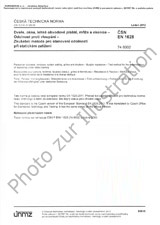Wir benötigen Ihre Einwilligung zur Verwendung der einzelnen Daten, damit Sie unter anderem Informationen zu Ihren Interessen einsehen können. Klicken Sie auf "OK", um Ihre Zustimmung zu erteilen.
ČSN ETSI EN 300392-3-12-V1.2.1 (875042)
Terrestrial Trunked Radio (TETRA); Voice plus Data (V+D); Part 3: Interworking at the Inter-System Interface (ISI); Sub-part 12: Transport layer independent Additional Network Feature Individual Call (ANF-ISIIC)
Name übersetzen
NORM herausgegeben am 1.11.2020
Informationen über die Norm:
Bezeichnung normen: ČSN ETSI EN 300392-3-12-V1.2.1
Zeichen: 875042
Katalog-Nummer: 510774
Ausgabedatum normen: 1.11.2020
SKU: NS-1008304
Zahl der Seiten: 120
Gewicht ca.: 391 g (0.86 Pfund)
Land: Tschechische technische Norm
Kategorie: Technische Normen ČSN
Kategorie - ähnliche Normen:
Die Annotation des Normtextes ČSN ETSI EN 300392-3-12-V1.2.1 (875042):
V1.2.1
The present document defines the Terrestrial Trunked Radio (TETRA) system supporting Voice plus Data (V+D). It specifies:
- - the interworking of individual calls between TETRA networks;
- - the supplementary services interaction with individual calls between TETRA networks.
The TETRA V+D interworking - basic operation part defines the interworking between TETRA networks over the corresponding interface: the Inter-System Interface (ISI). It comprises the following sub-parts:
- - Transport layer independent General design [2];
- - General Design, PSS1 over E.1 [3];
- - General Design, SIP/IP [4];
- - Transport layer independent Additional Network Feature - ISI Individual Call (ANF-ISIIC) (the present document);
- - Transport layer independent Additional Network Feature - ISI Group Call (ANF-ISIGC) [5];
- - Transport layer independent Additional Network Feature - ISI Short Data service (ANF-ISISDS) [i.8];
- - Transport layer independent Additional Network Feature - ISI Mobility Management (ANF-ISIMM) [6];
- - Generic Speech Format Implementation [i.7].
The present document is the ANF-ISIIC sub-part.
Like all other Additional Network Feature (ANF) specifications, those of ANF-ISIIC are produced in three stages, according to the method described in Recommendation ITU-T I.130 [i.4]. The present document contains the stage 1 and 2 descriptions of ANF ISIIC, and stage 3 description. The stage 1 description specifies the ANF as seen by its users, which are essentially the individual call control entities in both TETRA networks. The stage 2 description identifies the functional entities involved in the ANF and the information flows between them. And the stage 3 description of ANF-ISIIC specifies its protocol.
NOTE 1: According to Recommendation ITU-T I.130 [i.4], the stage 3 description of a bearer or tele-service addresses the network implementation aspects. Consequently, it comprises two steps: the specifications of all protocols at the various reference points involved in any of the service procedures (notably the service operation) are the first step of the stage 3 description, and the specifications of the functions of the corresponding network entities are its second step.
NOTE 2: The SDL diagrams have not been provided since they can be derived from the specification of the functional entity actions in the stage 2 description.
The present document applies to TETRA networks which support inter-TETRA individual calls. More specifically, it applies to their Circuit Mode Control Entities (CMCE), as defined in clause 14.2 of ETSI EN 300 392-2 [1], and to their ANF-ISIIC entities defined in the stage 2 description.
The relation between the ANF-ISIIC and the transport layer protocol is described in the General Design documents [2], [3] and [4]
Normansicht ČSN ETSI EN 300392-3-12-V1.2.1 (875042)
Empfehlungen:
Aktualisierung der technischen Normen
Wollen Sie sich sicher sein, dass Sie nur die gültigen technischen Normen verwenden?
Wir bieten Ihnen eine Lösung, die Ihnen eine Monatsübersicht über die Aktualität der von Ihnen angewandten Normen sicher stellt.
Brauchen Sie mehr Informationen? Sehen Sie sich diese Seite an.




 Cookies
Cookies
